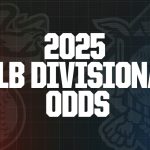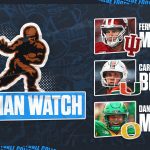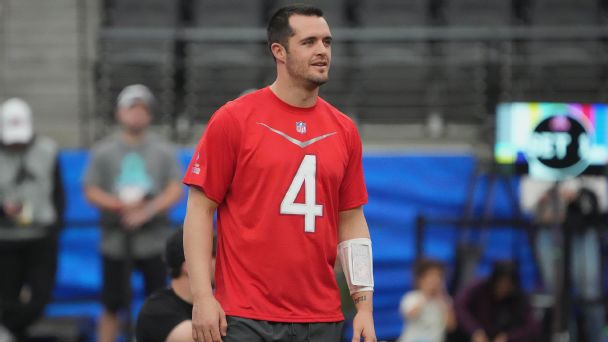
HENDERSON, Nev. — The star-crossed Derek Carr era with the Las Vegas Raiders is over … unless it isn’t. The most polarizing figure in franchise history — his fans adore him, his detractors abhor him and there is no middle ground — was benched with two games to go in the regular season and left the team, purportedly to not become a distraction.
The move, fueled by economics and a lack of results, set in motion a strange series of events that has the quarterback who holds virtually every career franchise passing record — including 35,222 passing yards and 217 touchdown passes — looking for a new home.
The feeling the past few years, dating from former coach Jon Gruden to interim coach Rich Bisaccia to current coach Josh McDaniels, in the Raiders’ building was that Carr was never the problem, but many wondered if he was the answer. And if you had to ask that question, maybe you did have a problem.
And as ESPN NFL insider Adam Schefter reported late last week, the Raiders have granted Carr’s camp permission to speak with teams that have already agreed to the as-of-yet unknown compensation Las Vegas is looking for in a trade. Carr, who has a no-trade clause in his contract, will meet with the New Orleans Saints on Wednesday. It’s a game of hurry up and wait as a deadline of Feb. 15, when more than $40 million in guarantees kicks in, looms.

OK, so what happens on Feb. 15, and why was that date chosen?
Three days after the Super Bowl, $40.4 million of Carr’s three-year, $121.5 million extension, signed last spring, becomes guaranteed. Unless the Raiders cut him before that date. If they cut him, the Raiders will take on a $5.6 million salary cap hit but free up $29.3 million in cap room. And if Las Vegas trades Carr, the Raiders also take a $5.6 million cap hit while freeing up $29.3 million in cap room but would obviously get assets back in the trade.
If the Raiders stand pat and do nothing with Carr on Feb. 15, the quarterback is guaranteed the $40.4 million, by the Raiders or whichever team picks up his contract in a potential post-Feb. 15 trade. Keep in mind, Carr said at the Pro Bowl that he has no intention of moving the Feb. 15 deadline back to help the Raiders facilitate a trade, and trades cannot become official until the start of the new league year on March 15.
The date was chosen by Carr’s camp in negotiations for the extension to give Carr, should he be released, a month’s head start on everyone else in free agency, providing him the advantages built in with being the first free agent QB on the market. Combine that with the no-trade clause Carr got in the extension and it gave him a good handle on being able to choose his next destination should it come to that.
But if it’s simply about money, he’d want to go to a place that’s going to pay him at least the $40.4 million he would have been guaranteed anyway, right? And if you’re a team that covets Carr, why would you weaken yourself by giving up assets in a trade for him when you figure you can get him on the open market anyway, perhaps even at a lower rate than $40.4 million guaranteed? It’s that same game of hurry up and wait, while seeing who will blink first.
Let’s rewind: How did the Raiders and Carr get to a crossroads?
Simply put, it was time. Throw in the financial aspect — the $40.4 million becoming guaranteed — and it became kind of a no-brainer from the Raiders’ perspective, even if Carr becomes a hot commodity on the free agent market after being cold in the trade market.
True, in nine years Carr played for six different coaches (Dennis Allen, Tony Sparano, Jack Del Rio, Jon Gruden, Rich Bisaccia and Josh McDaniels), had four different playcallers (Greg Olson, Bill Musgrave, Todd Downing, Olson again and McDaniels) and was backed by a bottom-feeding defense for virtually his entire tenure. Yet even with QBs getting too much credit when things go right, and too much blame when they go wrong, Carr’s 63-79 career record without a playoff victory — he did take two teams to the playoffs but crushingly missed the first trip with a broken leg suffered in the penultimate game of the 2016 season — was too much to overlook when deciding to bring him back for a 10th season.
The Raiders were just 12-44 against playoff teams with Carr at QB. Plus, there were Carr’s infamous issues in cold-weather games — since entering the league in 2014, he is just 2-10 with a total QBR of 33.6 (44th out of 47 qualified quarterbacks), a 58.0% completion percentage and a 14-14 TD-INT ratio in games where the temperature is 40 degrees or colder, 1-7 with a 35.5 QBR (35th out of 46 QBs) and an 8-9 TD-INT ratio when the game is played at 32 degrees or colder.
Still, Carr was a bright spot in an abyss at the position, the team’s first true franchise QB since Rich Gannon played his last game in 2004, and when the Raiders entered the offseason of 2014, their QB wish list was Matt Schaub, Mark Sanchez and Michael Vick. Carr dropping to them in the second round, No. 36 overall, was fortuitous, given how Schaub developed “dead-arm” syndrome in the preseason. Carr overtook the vet and never looked back until late this season.
With two games to go and the Raiders still mathematically alive for a postseason spot, Carr was benched and he left the team in what was described as a “mutual decision” — still, a strange decision by a guy who had been the face of the franchise since being drafted.
Basically, if absence makes the heart grow fonder, familiarity breeds contempt. And here we are.
The Raiders obviously would prefer a trade, right? So what are they seeking?
The closer we get to the Feb. 15 deadline, the lower the price for Carr’s services seemingly becomes. And the Raiders would like something, anything, in return for a guy who was just named to his fourth Pro Bowl, albeit the third time as an alternate. From the Raiders’ perspective, they would no doubt like talks to begin with at least a first-round draft pick. It’s hard to see them settling for anything less than a third-rounder. The risk, then, is agreeing to a trade with a team and said team backing out before it can become official on March 15 as a lot can happen in a month’s time. So, a lot of trust has to be involved from the Raiders’ end. A lot of trust.
Beware the ides of March? Beware a team getting a case of buyer’s remorse after agreeing to a trade but before the start of the league year, or Carr, after agreeing to a trade, deciding he’d rather play somewhere else or hit the open market and exercise his no-trade clause. Matthew Stafford (January 2021), Alex Smith (January 2018) and Russell Wilson (March 2022) are examples of QBs who were traded by their respective teams in pre-new league year agreements that went swimmingly, so to speak.
And if they can’t find a trade partner, or Carr does not agree to a trade?
There’s a hope held by many Carr fans that the Raiders will see the, ahem, error of their ways and simply roll out the mea culpas and ask him to return. Sorry, can’t see it happening. Not even with Carr saying two summers ago that he would “probably” retire rather than play for a team other than the Raiders, but especially with Carr leaving his teammates with two games to play and still getting a Pro Bowl nod after Patrick Mahomes was excused for the Super Bowl, Josh Allen and Joe Burrow opted out due to injury and Lamar Jackson, Justin Herbert and Tua Tagovailoa were hurt.
Carr said he spoke with AFC Pro Bowl coach Peyton Manning, who had been cut in his career, about the process. “You just go to the next place and you move on,” Carr said. “You do your best there.” Yeah, Carr has seemingly turned the page.
Derek Carr got jokes 🍿 😂
📺 ESPN pic.twitter.com/BqSFkyUha4
— SportsCenter (@SportsCenter) February 3, 2023
Plus, it’s not hard to imagine Raiders owner Mark Davis tiring of the whole process and telling GM Dave Ziegler and McDaniels to go the quick and dirty route, to simply cut Carr and take the $5.6 million salary cap hit which, with the cap going up some $18 million for 2024, is relatively negligible, especially with that extra $29.3 million in cap room, as noted earlier.
True, the Raiders, who already have more than $20 million in cap space, get nothing in return this route, as opposed to a trade, but they are able to move on. With a projected 11 draft picks upcoming, including the No. 7 overall selection, they’d still have the assets to address glaring holes and needs on the roster.
So why did the Raiders give Carr a no-trade clause in his extension?
Negotiations are always a give-and-take, right? Carr’s camp wanted it and, it would seem, the Raiders then were able to use this past season, Carr’s first in McDaniels’ system, as a prove-it year. And, obviously, he didn’t prove it to the new regime. Sure, the Raiders are bent a little awkward by the no-trade clause and the month-ahead deadline for his $40.4 million guarantee to kick in. But the flip side of that was the ability to move on with that relatively inexpensive $5.6 million salary cap hit. It’s the yin and yang of negotiations.
So what are the Raiders’ quarterback options for 2023, as in, who’s next?
Option No. 1, Tom Brady, retired last week. So, with a vet having familiarity in McDaniels’ system a seeming prerequisite, all eyes next turn to Jimmy Garoppolo, who will not return to the San Francisco 49ers next season and is coming off a foot injury. But if the best ability is availability, and Garoppolo has missed 18 games over the past three seasons, how much sense does it make to invest in a guy who turns 32 in November? (Carr has missed only two games due to injury in his career).
Brady would have been a bridge, no doubt, but at just eight months younger than Carr, is Garoppolo the future in Las Vegas? Rumors are already heating up regarding a potential trade for future Hall of Famer Aaron Rodgers, who, remember, was taken by the Packers in 2005, one selection after the Raiders selected cornerback Fabian Washington. Kind of like the Raiders taking offensive lineman Don Mosebar one pick ahead of … Dan Marino in 1983. Ouch. And Rodgers has no relationship with McDaniels, though Davante Adams does from his eight years in Green Bay. And Adams was advocating for Rodgers to join him in Las Vegas at the Pro Bowl. Acquiring Rodgers, though, would be expensive, and cost assets in a trade.
Mine. https://t.co/1w4jX42A0q
— Davante Adams (@tae15adams) February 2, 2023
What might make the most sense, then, is for Las Vegas to re-sign Jarrett Stidham, who would be significantly cheaper to sign than the aforementioned veterans, has known only McDaniels’ system in his four-year NFL career and looked more comfortable in his first career start, against the 49ers’ No. 1-ranked defense, than Carr did in 15 starts. Then the Raiders could use their picks to move up from the No. 7 pick to grab Ohio State’s C.J. Stroud, Kentucky’s Will Levis or Alabama’s Bryce Young, or possibly even drop back and take Florida’s Anthony Richardson.
Keep in mind, the Raiders have used a first-round pick on a quarterback only three times since the 1970 AFL-NFL merger, with results ranging from the sublime to the ridiculous thanks to Marc Wilson (1980), Todd Marinovich (1991) and JaMarcus Russell (2007). Buckle up.










